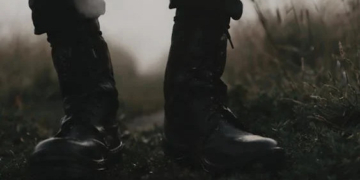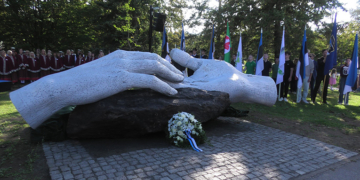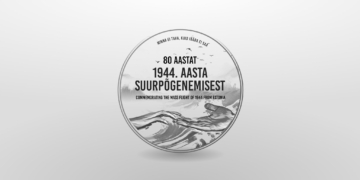My Search for the Spirit of Kalevipoeg
Royce Willis
Community is at the heart of all of us. We need it to develop, grow, and survive. We need it for happiness, togetherness, and a sense of belonging. We need it to be people.
When I was younger, community didn’t mean very much to me. As I’ve grown up, though, I’ve started realizing its true importance. The more independent I become, the more I notice that I can only achieve my goals with the help of others. One of the most important communities is that of our heritage, as that is the one aspect of our lives that is a constant, from birth to death. For myself and perhaps many reading this, our community of heritage is the Estonian community. Even though I’m currently separated by about 6,000 miles from Estonia, thanks to my mom, I still carry an Estonian identity. I’ve recently started to appreciate this community much more, as the one that will always stick with me. As a result, I’ve also tried to get much more involved with it, as the only way to feel supported is to support others. While there’s no one way to officially join the community, I make an effort to do anything possible to just get me one step closer. Each time I have the chance to visit the Los Angeles Estonian House, experience any bit of Estonian culture, or even just practice my Estonian, I feel a little bit more like I belong. This is my journey through the communities in my life, and my experiences as an Estonian.
But first, an anecdote. To me, one integral part of becoming a contributing member of the community is learning the Estonian language. Each week, I take two online language lessons with a New York-based teacher. Oftentimes, these are the highlights of my week. Not only do I get to have fun learning, but I also get a real sense of belonging. After each class, I get assigned homework, which most of the time consists of a story I have to write.
In one of my first classes, I chose Kalevipoeg as one of the main characters in my story. Why? When I heard the Estonian founding epic for the first time, I thought it inspiring how one story inspired a whole nation. The whole community rallies around Kalevipoeg in times of both peace and war. I wanted him to be an integral part of each class, as a reminder for my motives behind taking Estonian in the first place. I also wanted to have him be an integral part of this essay, as the one thing that really symbolizes community for me and thousands of others. (Just to note, I will be using William Forsell Kirby’s “The Hero of Esthonia and Other Studies in the Romantic Literature of That Country”, produced by Ted Garvin, Taavi Kalju, and the Online Distributed Proofreading Team as the source of all my quotes.)
Throughout my life, I’ve journeyed through many communities, both positive and negative. The first true community I ever experienced outside of my home was my French school. I remember showing up to my first day, standing on a red bridge in the middle of campus before class. I kept looking at the other kids, longing to one day be a part of their conversations, even though their French sounded like gibberish to me.
“The son of Kalev then sprang into the sea, swam ashore, and towed the ship after him. The birds sang to them that it was the poverty-stricken coast of Lapland. They went to explore the country, but wandered a long way without meeting with any inhabitants. At last they found a solitary cottage, where a maiden sat on the grass plot before the door spinning.” (Page 112-113)
Walking into the school for the first time, I felt like Kalevipoeg and his companions in Lapland, who had just arrived on a desolate shore. Even though there were hundreds of kids around me, it seemed like there were no real inhabitants at the school, nobody whom I could relate with.
Eventually, though, I started warming up to my classmates and teachers, and I started learning French. Just like how Kalevipoeg eventually found a cottage in the desolate plains, I found some people who turned out to be just like me. I personally feel it’s impossible to stay alone when you’re surrounded by people, no matter who.
My experience in the French and broadly international community was mostly positive, but I definitely never felt French, even if I knew the language well. I enjoyed the taste of the galette des rois we ate on special holidays, but I still wished for some vastlakukkel instead. The funny thing is, the less I felt French, the more I started finding out who I really was: Estonian. School eventually ended and, voilà, so did many of my friendships.
“After this the three brothers took an affectionate leave of each other, and the two elder ones wandered cheerfully away. The youngest sat on the rock sadly reflecting on the lost joys of youth, and how he must now depend on his own unaided efforts. At length he threw a silver coin into the water as an offering to the gods, an old custom now forgotten.” (Page 58)
In the summer leading up to my third-grade year, I felt like Kalevipoeg when his two brothers left, and I now realized just how important my classmates were to me. It was the first time I had started to grasp the vitality of community, since I was deprived of it. My old friends were either vacationing in France or celebrating French Bastille Day, but I, as someone who left the school, had to find new ones for the next chapter of my life.
Luckily, I was taught an important lesson early on: communities are essential, but they do take effort. At my next school, I was determined to form friendships that would stick throughout the summer and beyond that. I decided the best way to do this was to get involved, and through clubs like Model UN or Leadership, I got to know more people and more potential friends for life. Even today, over a year since my last class, I still chat with my friends in Leadership, and I still remember so many positive experiences. I recall staying after school for days trying to finish building a gaga pit with my friends, all of us working away in the heat. It may not have been a completely enjoyable experience, but it sure was one that built team spirit. Thanks to my effort, my friendships from middle school still last today, and I still feel like I’m a part of that community.
“Sarvik rules his subjects with great severity; but once a year, on All Souls’ Day, they are permitted to revisit their homes, to see and salute their friends and relatives. They rush up in shoals, on these occasions, to the places which they once inhabited in joy or grief; but as soon as their time is over they are compelled to return, each to his own dwelling.” (Page 98)
Each time I get to see my old friends again at various get-togethers, I feel like Sarvik’s servants on All Souls’ Day, getting to revisit their old community and reminisce on the past. While it’s true that the horrible Sarvik isn’t actually looking over me, I still feel like my time with my old friends is limited, but still available. I learned the power of community, as something that can really withstand the
tough test of time.
While these are all valuable communities that have shaped me, I feel there’s one community that is stronger than all others: the Estonian community. As I alluded to above, the only thing ever present from birth to death is our heritage. Each one of us has an internal sense, something that stirs in us when discussing our homeland. This internal feeling guides many of us to join others with similar backgrounds. This is especially pronounced when your homeland has a tight-knit and influential community like Estonia.
I feel that I’m incredibly lucky to be Estonian. Unlike at school or with any other organizations, I feel Estonia and its people will always be there for me. The more fickle the world seems to get, the more fulfilling one constant is. When I was younger, I didn’t have many connections to the Estonian community, as my Estonian mom had just left Soviet-occupied Estonia and wanted to assimilate to succeed in America herself, keeping up with only a few close friends from back home. While she deserves no blame in doing so, I wish that I was brought up around the community of Estonia, so I could take advantage of my luck to be included in such a special group. This is why I’ve started to do everything I can to become more involved and learn about this unique community and all its different aspects so that I can give back to it in the future.
I’ve learned there are many different dimensions to the Estonian community, and many different ways to take part. However, I think the most important piece of it, and most other communities, are the people. After all, without Estonians themselves, the community could never exist in the first place. I’ve made an effort to try to meet as many new people as possible.
“Guests gathered to the wedding from far and near, and even the oaks and alders came, roots, branches, and all. / After this they danced the cross-dance, / Waltzed the waltzes of Esthonia,” (Page 14)
As in the quote, each time I visit the Eesti Maja (Estonian House) in Los Angeles, practice my (lack of) language skills with my grandma, or actually go to Estonia, I meet so many different Estonians. Each time I meet a new person, I feel like I get another puzzle piece to add to the picture of the whole story of the community, and the more I feel Estonian.
The Estonian community isn’t only one group: there are different smaller communities within it. For example, the culinary community. One of my favorite things to do is to take a trip to the local Eastern European market and try to pick out foods from Estonia or the other Baltic countries. We normally come home from the market with bags full of kohuke, Riga sprats, Estonskaya sausage, Napoleon cake, and lehmakomm. Not only do these foods taste great, but they also remind me of my times in Estonia. Each bite makes me feel a little more Estonian.
Another part of the Estonian community that I’m passionate about is Eesti Laul, a singing competition. Each year, I’m excited to listen to all the new songs, and my family and I write down ratings for all of them. I always like the songs in Estonian, as I can translate them with my teacher, and I feel they represent the country the best. No matter the song, I always hope Estonia does well in the actual Eurovision final. I can recall many old Eesti Laul songs that I absolutely loved, and still do.
From the incredible voice of Ott Lepland’s “Kuula” to the enchanting “Rändajad” by Sandra Nurmsalu and Urban Symphony, these songs really are my favorite songs ever. I feel so much pride and joy when I hear thousands of Estonians singing a song in their native language. Each time I hear one such song, it makes me feel more Estonian.
Finally, one of the most important things about being Estonian is knowing Estonian. After all, how could I interact with others without speaking the same language? Without knowing the language, I feel like I miss out on a few subtle and hidden nuances that natives can easily pick up on. I started taking Estonian lessons online with teachers both in Estonia and the United States. The two lessons a week really are some of my favorite times, because I get to learn about both culture and language. While it can sometimes be difficult to distinguish between kus, kuhu, and kust, it’s all worth it. This continues with my homework, when I incorporate some form of Estonian culture into our lesson, such as the story of paljas siil:
“Presently his load was nearly exhausted, and the sorcerer’s sons, hoping now for an easy victory, pressed him more hardly, when suddenly he heard a little voice crying from the bushes, ‘Dear son of Kalev, strike them with the edges!’ The hero at once took the hint, and, instead of striking with the flat side of the planks, began to strike with the sharp edges, and his enemies soon fled before him, howling like wolves… The hedgehog crept out of his warm nest, naked and shivering, and the hero cut a piece from the lining of his own coat, and gave it to the hedgehog, who joyfully wrapped himself in the warm covering.” (Page 81-82)
Ever since the start of my Estonian learning, I’ve been interested in learning more about Kalevipoeg. The stories I write for homework often involve characters like paljas siil (the naked hedgehog who helped Kalevipoeg in the quote above) or Kalevipoeg himself. Only for this essay, though, did I actually read the national epic. While it was surprisingly difficult to find an English version here in Los Angeles, I felt it essential to my understanding of the community at all to know about its central figure. After reading the epic, I understand now why it’s so important to the Estonian people. Kalevipoeg represents each and every Estonian, with all his strengths and his faults, and all of us together. It represents the Estonian nation and independence. While reading Kalevipoeg, I couldn’t help but feel incredibly patriotic. Learning from this extensive compilation of folk tales and mythical stories of ancient Estonians, I truly started to understand what it means to be Estonian. As long as we stand together with our community and cherish our culture, I feel that the spirit of Kalevipoeg is looking over us, making sure Estonia and its people will endure forever.
“But one day a vast fire will break out on both sides of the rock and melt it, when the Kalevide will withdraw his hand, and return to earth to inaugurate a new day of prosperity for the Estonians.” (Page 143)
The other 2 winning essays will be published in the next “Väike Eesti Sõna”.

























